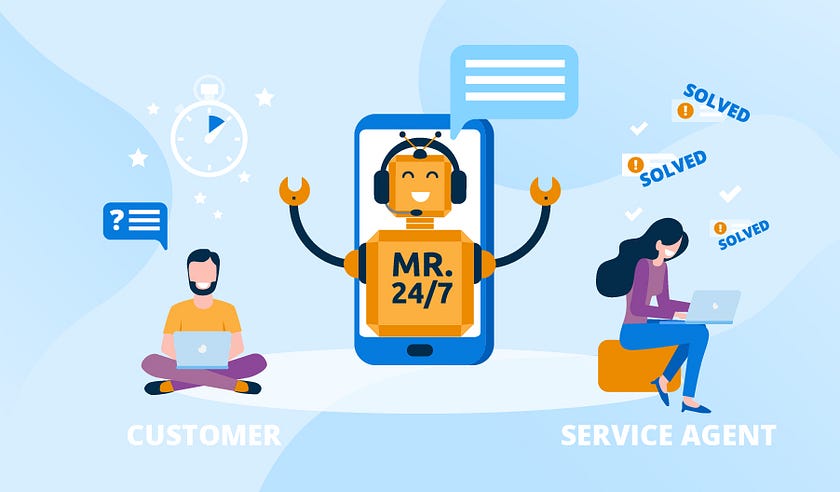Chatbot Customer Service: What It Is & Its Use Cases

Introduction
In today’s fast-paced digital world, customers expect instant answers and round-the-clock support. Businesses can no longer afford to make their customers wait in long queues or delay responses. This is where chatbot customer service steps in — a modern solution that blends technology, convenience, and efficiency.
Chatbots are changing how brands interact with their customers by providing quick, personalized, and accurate support — all without human intervention. Let’s explore what chatbot customer service really is, how it works, and the key use cases that make it an essential part of modern customer experience.
What Is Chatbot Customer Service?
Chatbot customer service is the use of AI-powered virtual assistants or automated chat systems to handle customer queries, provide information, and assist in problem-solving through text or voice-based conversations.
These bots are designed to simulate human interaction by understanding customer intent, processing requests, and responding intelligently — whether on a website, mobile app, or messaging platform like WhatsApp or Facebook Messenger.
Modern chatbots can do much more than just answer FAQs — they can book appointments, process orders, track deliveries, and even upsell products. They’ve become an integral part of Customer Experience (CX) strategies across industries.
How Do Chatbots Work?
Chatbots rely on a mix of Artificial Intelligence (AI), Natural Language Processing (NLP), and Machine Learning (ML) to understand and respond to user inputs.
Here’s a simple breakdown:
- Input Recognition: The chatbot identifies the user’s question or command.
- Intent Analysis: It interprets the meaning using AI and NLP to understand what the user wants.
- Response Generation: The chatbot provides a relevant answer or performs an action — for example, showing a product, processing a refund, or transferring the chat to a human agent if needed.
The more a chatbot interacts with users, the smarter it becomes — continuously learning from past conversations to improve accuracy and customer satisfaction.
Why Businesses Are Using Chatbot Customer Service
The benefits of chatbot-driven support go beyond automation. Businesses adopt them because they bring efficiency, scalability, and personalization to customer interactions.
- 24/7 Availability: Chatbots never sleep — they’re available day and night, ensuring customers always get help when they need it.
- Instant Response Time: No waiting in line! Chatbots can handle multiple conversations simultaneously and respond instantly.
- Cost Efficiency: Reduces the need for large support teams by automating repetitive queries.
- Consistent Experience: Every customer receives uniform and accurate responses, reducing errors.
- Data-Driven Insights: Chatbots collect valuable information about customer preferences and pain points for future improvements.
Top Use Cases of Chatbot Customer Service
Let’s explore where chatbots are making the biggest impact:
1. Handling FAQs and Basic Queries
One of the most common uses of chatbots is managing frequently asked questions — like product availability, pricing, or delivery status. This frees up human agents to focus on complex issues while ensuring customers get immediate answers.
2. Order Tracking and Status Updates
E-commerce brands use chatbots to provide instant updates on order confirmations, shipment tracking, and delivery notifications — directly through chat.
3. Appointment Booking and Scheduling
In healthcare, salons, and service-based businesses, chatbots simplify booking by showing available slots, confirming appointments, and sending reminders — all automatically.
4. Customer Feedback Collection
Instead of lengthy surveys, chatbots can collect short, conversational feedback right after a service interaction, helping brands improve quickly.
5. Lead Generation and Product Recommendations
AI-powered chatbots can analyze customer behavior and suggest relevant products or services. For example, in retail, a chatbot can recommend clothing based on previous purchases or browsing history.
6. Technical Support
Tech companies use chatbots to guide users through troubleshooting steps, solving basic issues like password resets or app installation before escalating to human support.
7. Multilingual Customer Support
Chatbots can communicate in multiple languages, allowing global brands to deliver personalized support across different regions without expanding their staff.
The Human Touch: When Chatbots and Humans Work Together
While chatbots are excellent for routine interactions, they can’t fully replace human empathy. The best customer service models combine AI efficiency with human expertise.
For example, if a chatbot detects frustration or a complex issue, it can automatically transfer the conversation to a live agent. This hybrid approach ensures that customers get both quick answers and genuine care — creating the perfect balance between automation and personal attention.
Future of Chatbot Customer Service
By 2026, chatbots will become even more intelligent and emotionally aware. They’ll be able to detect tone, mood, and intent more accurately — allowing brands to offer hyper-personalized experiences. Integration with voice assistants, AR/VR, and advanced data analytics will make chatbot customer service a key pillar of digital transformation.
Conclusion
Chatbot customer service is not just a trend — it’s a revolution in how businesses communicate with customers. It brings speed, personalization, and scalability to customer interactions while lowering operational costs.
When used strategically alongside human agents, chatbots can transform support teams into powerful experience hubs that delight customers and build loyalty.
The future of customer service is intelligent, instant, and AI-driven — and chatbots are leading the way.


Comments
Post a Comment